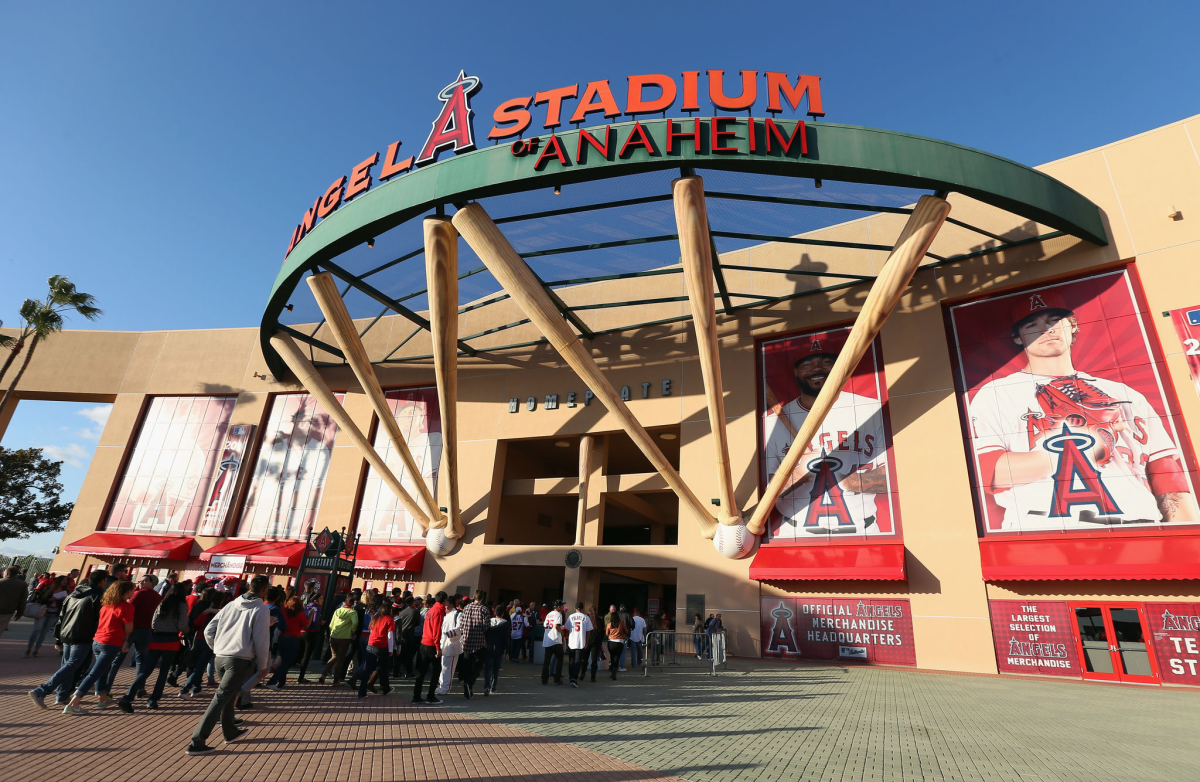Anaheim’s Big A study: Two years late at thrice the price. What happened?

- Share via
The city of Anaheim wanted out of the business of running a stadium. By selling Angel Stadium and the surrounding property to Angels owner Arte Moreno, the city would let him build a village atop the parking lots, and he could use the money he made to renovate or replace the ballpark.
In 2022, after the city killed the deal amid a federal corruption investigation into its former mayor, the Angels remained a tenant in the city-owned stadium. That compelled the City Council to ask two questions: Had the stadium been properly maintained in recent years? What would the stadium need to remain viable for several more decades?
On May 16, 2023, the council authorized a stadium evaluation for $325,000. The city executive in charge of the stadium told the council that night that the assessment and subsequent report would take “approximately two months” to complete.
Almost two years later, the project is not complete. It might not be complete for another year, and the cost is likely to exceed $1 million.
The Angels announced they have extended their Angel Stadium lease by three years, committing to playing at the venue through 2032.
“I believe that this is another point of evidence that the politics of our mayor and City Council are back to business as usual,” said Jose Moreno, the former councilman who pushed hardest for the stadium assessment, “which is to protect the special interests and the corporate interests of our city at the expense of the assets of the people of Anaheim.”
Mike Lyster, the city spokesman, said the project simply has become longer and more complicated than anticipated.
The city did receive a report in December 2023, he said. That report reflected more of a visual assessment — by way of a hypothetical example, he said, the assessment could have noted a crack in a section of concrete. In order to know whether that section could be patched or needed to be replaced, a detailed engineering inspection would be required.
In 2024, the city solicited proposals and assembled a team of contractors and subcontractors for such in-depth inspections and other studies. In 2025, he said, the city needs to work around the Angel Stadium event schedule to conduct those inspections, with the goal of completing the project in late 2025 or early 2026.
He estimated the added costs from $650,000 to $1 million.
“We understand the public would have the sentiment that it should go quicker,” Lyster said. “Unfortunately, there is a process we have to deal with, and we are talking about a stadium that is used year in and year out, even in the offseason.”
The Times asked two high-ranking baseball officials with experience in stadium management to estimate how long such a two-phase assessment project should take. The two, speaking independently of one another and granted anonymity for their candor, each said the project should take about six months.
The Times also filed public records requests to obtain a copy of the report the city received in December 2023. Anaheim commissioned the report through the city attorney, not the city executive in charge of the stadium, and so the city cited “attorney-client privilege” and “attorney work product privilege” in denying the public records requests.
Lyster said the city is “absolutely” committed to publicly releasing a final report. For now, he said, the city does not want to share information that is subject to change based on additional studies.
“It wouldn’t be responsible to go out there and release a preliminary report,” Lyster said.
On the surface, there would seem to be little urgency. The Angels this month exercised an option to extend their stadium lease through 2032, and there is little debate about what the assessment will show: Angel Stadium turns 60 next year, and it needs hundreds of millions of dollars of work to remain a viable major league ballpark for decades to come.
The stadium has had no major renovations since 1997. Dodger Stadium is four years older than Angel Stadium, and the owners of the Dodgers have invested more than $500 million in ballpark renovations since buying the team in 2012.
On two fronts, however, the issue is not just what the stadium requires in the years ahead but whether the Angels have properly maintained it in years past.
The city asked the company that conducted the initial assessment — the one the city has declined to release — to analyze how lease obligations requiring the Angels to maintain the stadium at a “first-class” level similar to Dodger Stadium and Kansas City’s Kauffman Stadium “relate to the current condition of Angel Stadium.”
Separately, two state legislators representing the Anaheim area asked state auditors last year to determine whether the Angels had “been taking steps to shirk responsibility in maintenance.” Sen. Tom Umberg (D-Santa Ana) said auditors have told him to expect a report this spring.
At the time the audit was announced, a team spokeswoman said the Angels were in “full compliance” with their lease obligations, and Lyster said the city had found the team in “general compliance.”
Moreno, the team owner, said he takes pride in keeping the ballpark safe and clean.
The Angels are spending in free agency during the offseason. But if this is really about contention, the Angels are back to being all about Mike Trout.
“My first thing is always safety,” Moreno said. “It’s an older stadium. We really work hard to maintain it. We put capital in there every year. We’ve always put in more capital than we are required to.”
The Angels could end their tenure at Angel Stadium in 2032, but they have an option to extend the lease through 2035 and another through 2038.
The team and the city could agree on a long-term deal, or the Angels could leave and the city could be stuck with an aging stadium and no team to play there.
“In the meantime, he can extend it for the next 13 years,” said Jose Moreno, the former councilman and no relation to Arte Moreno. “So who’s responsible for upgrading the stadium?”
More to Read
Go beyond the scoreboard
Get the latest on L.A.'s teams in the daily Sports Report newsletter.
You may occasionally receive promotional content from the Los Angeles Times.













